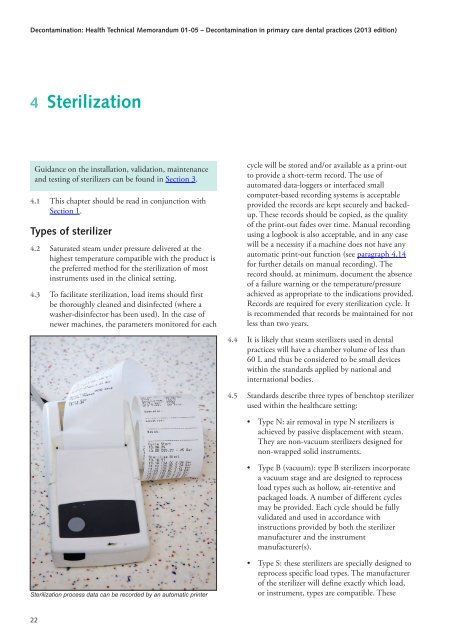Decontamination in primary care dental practices - Gov.uk
Decontamination in primary care dental practices - Gov.uk
Decontamination in primary care dental practices - Gov.uk
Create successful ePaper yourself
Turn your PDF publications into a flip-book with our unique Google optimized e-Paper software.
<strong>Decontam<strong>in</strong>ation</strong>: Health Technical Memorandum 01-05 – <strong>Decontam<strong>in</strong>ation</strong> <strong>in</strong> <strong>primary</strong> <strong>care</strong> <strong>dental</strong> <strong>practices</strong> (2013 edition)4 SterilizationGuidance on the <strong>in</strong>stallation, validation, ma<strong>in</strong>tenanceand test<strong>in</strong>g of sterilizers can be found <strong>in</strong> Section 3.4.1 This chapter should be read <strong>in</strong> conjunction withSection 1.Types of sterilizer4.2 Saturated steam under pressure delivered at thehighest temperature compatible with the product isthe preferred method for the sterilization of most<strong>in</strong>struments used <strong>in</strong> the cl<strong>in</strong>ical sett<strong>in</strong>g.4.3 To facilitate sterilization, load items should firstbe thoroughly cleaned and dis<strong>in</strong>fected (where awasher-dis<strong>in</strong>fector has been used). In the case ofnewer mach<strong>in</strong>es, the parameters monitored for eachcycle will be stored and/or available as a pr<strong>in</strong>t-outto provide a short-term record. The use ofautomated data-loggers or <strong>in</strong>terfaced smallcomputer-based record<strong>in</strong>g systems is acceptableprovided the records are kept securely and backedup.These records should be copied, as the qualityof the pr<strong>in</strong>t-out fades over time. Manual record<strong>in</strong>gus<strong>in</strong>g a logbook is also acceptable, and <strong>in</strong> any casewill be a necessity if a mach<strong>in</strong>e does not have anyautomatic pr<strong>in</strong>t-out function (see paragraph 4.14for further details on manual record<strong>in</strong>g). Therecord should, at m<strong>in</strong>imum, document the absenceof a failure warn<strong>in</strong>g or the temperature/pressureachieved as appropriate to the <strong>in</strong>dications provided.Records are required for every sterilization cycle. Itis recommended that records be ma<strong>in</strong>ta<strong>in</strong>ed for notless than two years.4.4 It is likely that steam sterilizers used <strong>in</strong> <strong>dental</strong><strong>practices</strong> will have a chamber volume of less than60 L and thus be considered to be small deviceswith<strong>in</strong> the standards applied by national and<strong>in</strong>ternational bodies.4.5 Standards describe three types of benchtop sterilizerused with<strong>in</strong> the health<strong>care</strong> sett<strong>in</strong>g:• Type N: air removal <strong>in</strong> type N sterilizers isachieved by passive displacement with steam.They are non-vacuum sterilizers designed fornon-wrapped solid <strong>in</strong>struments.• Type B (vacuum): type B sterilizers <strong>in</strong>corporatea vacuum stage and are designed to reprocessload types such as hollow, air-retentive andpackaged loads. A number of different cyclesmay be provided. Each cycle should be fullyvalidated and used <strong>in</strong> accordance with<strong>in</strong>structions provided by both the sterilizermanufacturer and the <strong>in</strong>strumentmanufacturer(s).Sterilization process data can be recorded by an automatic pr<strong>in</strong>ter• Type S: these sterilizers are specially designed toreprocess specific load types. The manufacturerof the sterilizer will def<strong>in</strong>e exactly which load,or <strong>in</strong>strument, types are compatible. These22
















